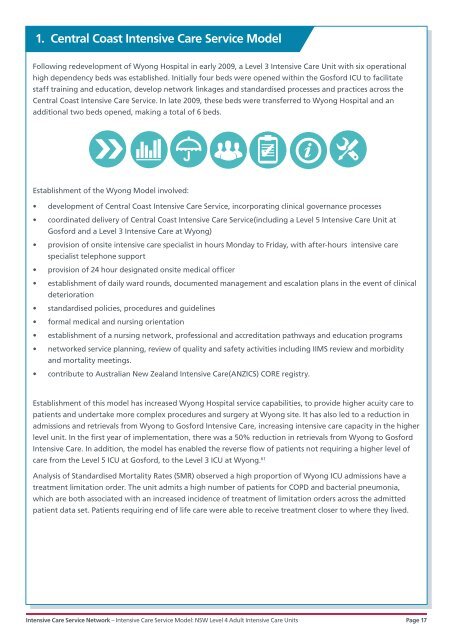Intensive Care Service Model NSW Level 4 Adult Intensive Care Units
1Olm7HQ
1Olm7HQ
Create successful ePaper yourself
Turn your PDF publications into a flip-book with our unique Google optimized e-Paper software.
1. Central Coast <strong>Intensive</strong> <strong>Care</strong> <strong>Service</strong> <strong>Model</strong><br />
Following redevelopment of Wyong Hospital in early 2009, a <strong>Level</strong> 3 <strong>Intensive</strong> <strong>Care</strong> Unit with six operational<br />
high dependency beds was established. Initially four beds were opened within the Gosford ICU to facilitate<br />
staff training and education, develop network linkages and standardised processes and practices across the<br />
Central Coast <strong>Intensive</strong> <strong>Care</strong> <strong>Service</strong>. In late 2009, these beds were transferred to Wyong Hospital and an<br />
additional two beds opened, making a total of 6 beds.<br />
Establishment of the Wyong <strong>Model</strong> involved:<br />
• development of Central Coast <strong>Intensive</strong> <strong>Care</strong> <strong>Service</strong>, incorporating clinical governance processes<br />
• coordinated delivery of Central Coast <strong>Intensive</strong> <strong>Care</strong> <strong>Service</strong>(including a <strong>Level</strong> 5 <strong>Intensive</strong> <strong>Care</strong> Unit at<br />
Gosford and a <strong>Level</strong> 3 <strong>Intensive</strong> <strong>Care</strong> at Wyong)<br />
• provision of onsite intensive care specialist in hours Monday to Friday, with after-hours intensive care<br />
specialist telephone support<br />
• provision of 24 hour designated onsite medical officer<br />
• establishment of daily ward rounds, documented management and escalation plans in the event of clinical<br />
deterioration<br />
• standardised policies, procedures and guidelines<br />
• formal medical and nursing orientation<br />
• establishment of a nursing network, professional and accreditation pathways and education programs<br />
• networked service planning, review of quality and safety activities including IIMS review and morbidity<br />
and mortality meetings.<br />
• contribute to Australian New Zealand <strong>Intensive</strong> <strong>Care</strong>(ANZICS) CORE registry.<br />
Establishment of this model has increased Wyong Hospital service capabilities, to provide higher acuity care to<br />
patients and undertake more complex procedures and surgery at Wyong site. It has also led to a reduction in<br />
admissions and retrievals from Wyong to Gosford <strong>Intensive</strong> <strong>Care</strong>, increasing intensive care capacity in the higher<br />
level unit. In the first year of implementation, there was a 50% reduction in retrievals from Wyong to Gosford<br />
<strong>Intensive</strong> <strong>Care</strong>. In addition, the model has enabled the reverse flow of patients not requiring a higher level of<br />
care from the <strong>Level</strong> 5 ICU at Gosford, to the <strong>Level</strong> 3 ICU at Wyong. 61<br />
Analysis of Standardised Mortality Rates (SMR) observed a high proportion of Wyong ICU admissions have a<br />
treatment limitation order. The unit admits a high number of patients for COPD and bacterial pneumonia,<br />
which are both associated with an increased incidence of treatment of limitation orders across the admitted<br />
patient data set. Patients requiring end of life care were able to receive treatment closer to where they lived.<br />
<strong>Intensive</strong> <strong>Care</strong> <strong>Service</strong> Network – <strong>Intensive</strong> <strong>Care</strong> <strong>Service</strong> <strong>Model</strong>: <strong>NSW</strong> <strong>Level</strong> 4 <strong>Adult</strong> <strong>Intensive</strong> <strong>Care</strong> <strong>Units</strong> Page 17


